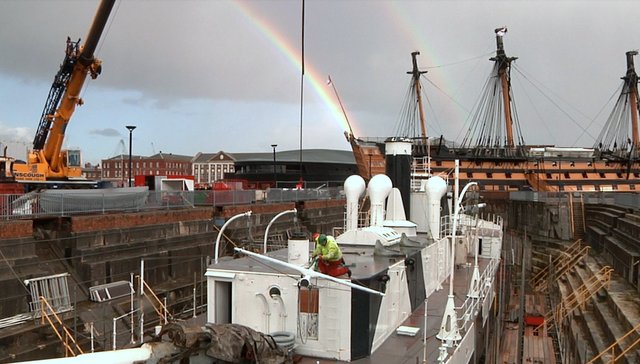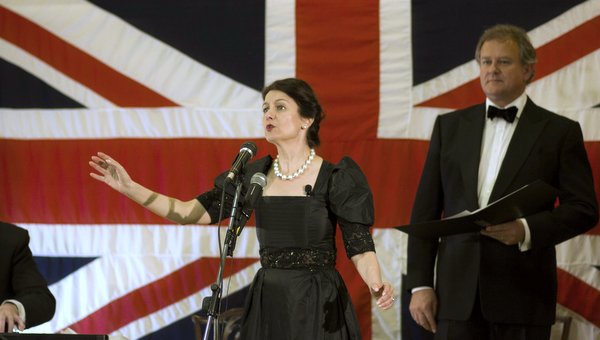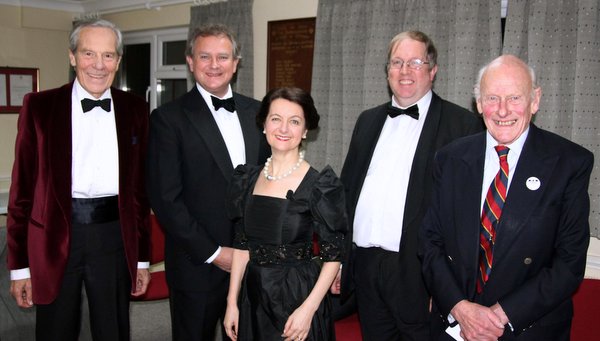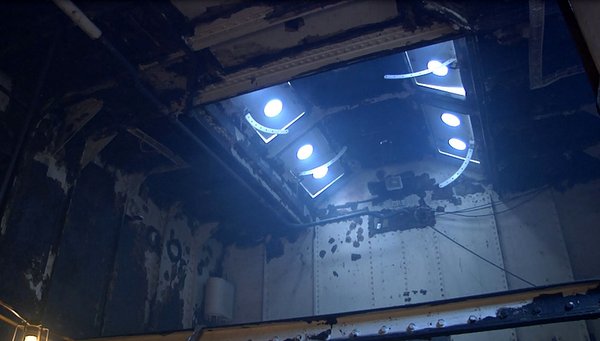What you really want from your client – the endorsement of the film you’ve made. And Matthew Sheldon of the National Museum of the Royal Navy has given a clear thumbs-up to our film about HMS M33 – the first of four and maybe five. The refit, and later new-fit, of the veteran ship is going ahead at speed, with great plans for open access for the public, able and disabled alike. The key aim is to preserve as much as possible of the original fabric of this ‘monitor’, while telling her story and that of the RN in 1914-18 in a way that gets out there and grabs your attention. Watch this space as we track the progress of the project in a series of video blogs; and catch the first film ’HMS M33 – First World War Survivor’ at http://www.nmrn.org.uk/m33
‘To End All Wars’ wasn’t just about the star quality of Hugh Bonneville though – as he was the first to prove, being at once self-effacing and good-natured both during and after the event. Along with Martin, the show featured William Godfree singing and playing piano, and Fiona–Jane Weston singing and acting out the many roles women played during the First World War. The repertoire included classis like ‘Goodbyee’ and ‘Tipperary’ – but also extraordinarily moving moments such as those enacted by Fiona, with ‘Girls With the Bright Yellow Hands’ – a song about the impact on the health of the thousands of women who toiled in the munitions factories, where the explosives they handled turned their hands and skin yellow, and did far worse to them too. A great evening – a show that could transfer to the West End without breaking steps.
That was the title of an evening of poems, prose and songs held at Milland Village Hall in Hampshire. Just to prove that we don’t only shoot ships, Maritime Films UK filmed the event – but not really to show another string to our bow, actually to support this fund-raiser as it had been organized by a team including our ace presenter, Martin Muncaster (left in cast picture.) More than that, Hugh Bonneville (star of the new film ‘Paddington’, and of course ‘Downton Abbey’s Earl of Grantham in) had very kindly agreed to join up for the evening. All in aid of Combat Stress, which helps service people to deal with post-traumatic stress disorder – the terrible condition which won’t let your mind let go of traumatic events. And heaven knows our soldiers, sailors and aircrew have had plenty of those recently.
In factual TV there’s one thing every producer yearns for: good interviewees. People involved in what you’re filming who love what they’re doing, who can bring it to life with passion and commitment. Well, Maritime Films UK’s cup is overflowing when it comes to this project. Take Project Director Matthew Sheldon (picture.) Despite being involved in several other projects – which means he’s almost continuously on the move, day in, day out – he’s passionately committed to the project, totally, immersively involved. The on-site engineering team are great too, fully understanding the needs of TV, with Project Manager Martin Hobson coming back to give us an interview at the end of a 17 hour day. And conservation expert Jason Lowe is clearly fired up by the whole idea, of reaching back 100 years to stand in the footsteps of history. We’re lucky.
This (picture) is the engine room space. Here the mighty engines that drove HMS M33 along pounded away, day after day, to get her in position to unleash the ferocious power of her 6” guns. Think about that for a moment. Get your ruler out. Imagine that 6” shell, packed with high explosive, heading straight for YOU. You’re a Turkish gunner defending your homeland; but your lords and masters have made a bad call, and allied you with Imperial Germany, with its arrogant ambition to dominate Europe. HMS M33 is looking for you – and she won’t give up till she’s done what she was sent to do. The pity of war is that in the Dardanelles campaign, brave men on all sides, from Turkey, Britain, Australia and New Zealand, died to sort out the mess Europe’s politicians had made. Again.
Now it’s our turn to get inside HMS M33. And what a sight she is. Some might say “what a mess” as she’s had so many different roles since her World War I battles, including minelayer, workshop, fuelling hulk and even office space. So many of the spaces are not in their original shape, that most of the fixtures and fittings are gone (like the “heads”, or loos!) and that there’s a heap of work to do to get her ready for visitors in August, the anniversary of the Dardanelles campaign. The upside is that what we can film is incredibly evocative, with dramatic rust patternings, shafts of sunlight like solid bars shining into enclosed spaces, and of course the visual drama of brazing and welding. (See picture.) Nothing like a shower of sparks to liven up a dark shot…
Day 2 of filming the opening work on HMS M33 – and now it’s the turn of the 6” Hotchkiss gun, the after gunhouse and mast, and the whaler all to take flight onto the dockside of Dock No. 1. Once again, immense skill and care is required. But Paul, Darren, Phil and the ML team know what they’re doing and the whole lot gets aloft and across and down onto a safe landing. Seeing the whaler, the ship’s boat (picture) being hoisted up reminds you how heavy these boats are – a lot of weight to get overside and then to pull with oars, especially in a running sea. But that was normal for the Royal Navy of that era – as were the whaler races, with fierce competition between ships in harbour to see who’d end up ‘Cock o’ the Walk’!
And running and running, as we cover more “lifts”: the searchlight and the main mast. But then the lifting has to stop: the team are worried about the wind crossing the site – if any of these big heavy objects starts to swing and catches people or any part of the dock M33 is sitting in, things will get nasty. Very nasty. Plus, there’s only so much space on the narrow dockside to put stuff. So the team are proceeding with great care – after all this is truly historic stuff they’re handling. No care however will allow for the fact that the crosstree of the mainmast, which stands just behind the bridge, has rotted right through over the years, and snaps during the operation. Luckily it’s held on by cables so no harm done, but its removal is clearly very timely.
About Rob
Rob is a TV producer, reporter and camera operator with 30 years of experience at the BBC, Channel 4 and ITN, in news, factual and documentary production. He is a four-time award winner, whose awards include a coveted Royal Television Society award for his work on Channel 4 News. His association with the Maritime Foundation goes back to 1995 when he won the first Desmond Wettern Maritime Media Award for a series of reports that led to a major documentary on the loss of the bulk carrier Derbyshire.







